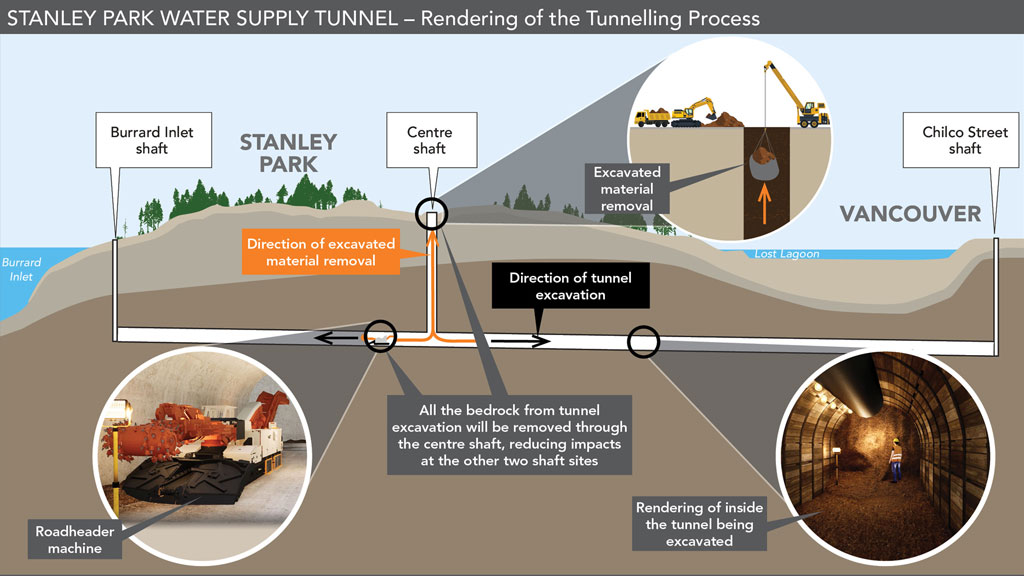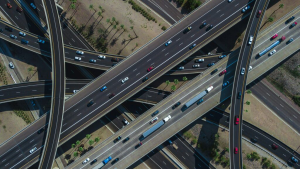By the end of this year, construction work is expected to start on building three shafts, valve chambers and a critical 1.4-kilometre-long, seismically resilient water supply tunnel deep underneath Stanley Park in Vancouver that will convey water to the city and other areas in the region.
The 2.6-metre-wide tunnel will be built 35 to 50 metres deep and the watermain, fed by the water supply from the North Shore reservoirs, will be built within or on bedrock to protect it in the event of an earthquake.
It will replace an existing trunk line that was built in the 1930s and is springing leaks.
“Population growth and climate change will continue to affect our drinking water supply and system, and we are planning for the future with these in mind,” explains Murray Gant, director of major projects – tunnels, at Metro Vancouver. “Once constructed, the new Stanley Park Water Supply Tunnel will meet current seismic standards to ensure continued reliability and increase the capacity of the existing system to accommodate the growing population.”
The project is pegged at $370 million.
Detailed design was completed in 2023. Metro Vancouver is in the process of hiring a contractor for the project. Completion of the watermain is slated for 2029.
Gant says site preparations and utility relocations may be started in advance. Regulatory approvals have been received from the Vancouver Fraser Port Authority, Parks Canada and the Vancouver Park Board.
Leaks of the existing watermain have been growing, including a major one in 2016. The pipe is a high-pressure, high-flow watermain, so a major rupture could cause significant problems and damage.
The long-awaited project will require the excavation of three separate shafts – the Burrard Inlet Shaft near Stanley Park Drive in the north which will connect to existing infrastructure that brings treated drinking water from the North Shore mountains under Burrard Inlet; the Centre Shaft off of Pipeline Road in Stanley Park which will be used to lower equipment to excavate the tunnel; and the Chilco Street Shaft site at Lost Lagoon in the south that will house pipes and valves to control the flow of water.
The locations of the shafts, along with the tunnel alignment and construction process, were carefully selected based on geotechnical, environmental, archeological, technological and traffic studies.Two valve chambers will also be built to house underground pipes and valves to control the flow of water through the mains in the area.
To start with, each shaft site will be prepared and temporary piping will be installed to maintain the existing water supply during construction. Then, soil and rock will be removed as part of the excavation of the shafts, valve chambers and tunnel.
A new watermain will then be installed and new valve chambers will be constructed at the Chilco and Burrard Inlet shaft sites. A new water connection to Stanley Park will also be constructed at the Chilco site.
Each construction area will be restored once construction work is completed. Final landscaping design is being led by the Vancouver Park Board and will include input from First Nations and the public.
To begin the tunnelling process, roadheader machinery will be lowered into the centre shaft and work outwards towards the other two shaft sites. The machinery is a piece of excavating equipment with a boom-mounted cutting head.
Between the Chilco and Centre shafts, the existing watermain will be slip-lined, which is essentially inserting a new pipe inside the old pipe and backfilling around it.
In addition to the roadheader, Gant says various types of heavy equipment such as cranes, trucks and excavators will be used for different activitie.
Because most of the work will take place deep underground, the public and visitors to Stanley Park shouldn’t experience any disruptions. In planning the project, Metro Vancouver has focused on maintaining access for park users and protecting the park’s public amenities and First Nations sites.
The project will not be without its challenges, however, as dust and noise at the construction sites along with truck traffic, are issues of concern.
Gant says dust mitigation measures will be introduced at each of the construction sites and the contractor will be responsible for control of dust, based on the types of activities and equipment used.
Noise will be monitored, and the contractor will be required to maintain equipment in good working in order to minimize noise, and also use additional measures to minimize noise wherever possible, he notes.
Metro Vancouver, in consultation with the City of Vancouver, will deploy a traffic management strategy to minimize impact in the area. The region will also provide traffic control personnel and signage to reduce congestion associated with construction.
“We are sensitive to the impacts that construction will have,” says Gant. “The project team has been engaging with the local community to understand their concerns and is taking steps to minimize impacts wherever possible.”











Recent Comments